The most delicious varieties of watermelons: description and characteristics
The modern seed market is represented by dozens of watermelon varieties. Among such a variety, choosing the best is not easy. The article will tell you about the juiciest and sweetest varieties and hybrids of melons.
You will learn how to choose the best variety according to the climatic conditions of the region and grow delicious fruits yourself.
What varieties of watermelons are there?
Among watermelons that are grown in open soil, there are: early ripening, mid ripening and late ripening.
When choosing a suitable type, take into account the following factors:
- plant resistance to drought and cold;
- susceptibility to parasites and diseases;
- ability to grow;
- need for fertilizers and care.
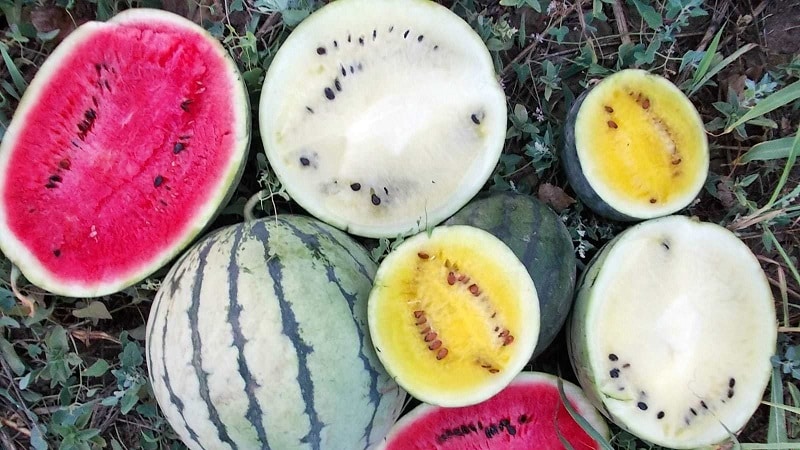
Early ripening
Despite the fact that watermelon is considered a heat-loving plant, it is also successfully cultivated in the northern regions. Modern agronomists have developed early varieties of berries even for Siberia. There is a large selection of seeds of early ripening varieties and hybrids on sale.
Ripe fruits vary in taste, size and color of pulp. The main unifying feature is rapid maturation. The growing season is 60-80 days. They are distinguished by their unpretentiousness: they tolerate heat and cold well.
In the southern regions, watermelons can grow up to 10 kg, in the northern parts their weight ranges from 2 to 5 kg. They have good productivity. Up to 7 kg of fruits are collected from one vine. They are characterized by thin skin and sweet, tender pulp.The shelf life of early varieties of berries is very short and is calculated in days. These fruits are best consumed immediately after picking.
Popular early varieties include:
- Ogonyok. Development occurs within 60-70 days. The ripe fruit has a round shape and elastic structure, and is green in color with a black tint. It is distinguished by its high juiciness and honey taste. Weighs from 3 kg. “Lights” are planted from late April to early May. This variety gives a good harvest and is immune to cold weather.
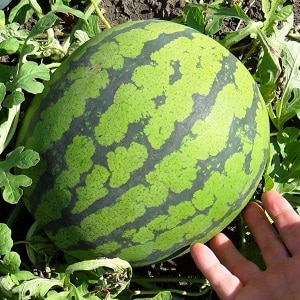 Gift to the North (on the picture). The fruits ripen in approximately 65 days. They are medium in size and oval in shape. They are distinguished by their juiciness and sugary taste. The variety is planted at the end of April. It is easy to care for and can resist many diseases.
Gift to the North (on the picture). The fruits ripen in approximately 65 days. They are medium in size and oval in shape. They are distinguished by their juiciness and sugary taste. The variety is planted at the end of April. It is easy to care for and can resist many diseases.- Skorik. These small greenish fruits ripen on approximately the 65th day. Distinctive features: blurry patterned stripes on the sides and thick peel. They have a sweet rich taste.
- Sugar baby. These fruits ripen one and a half months after planting. The stripes on the peel of the fruit are faint. The taste is sweet and juicy. They do not require special care. Resistant to cold and disease.
Mid-season
Mid-season varieties suitable for regions with long and warm summers. Such weather conditions create the possibility of long growing seasons for plants. Mid-ripening fruits accumulate much more sugars than early varieties.
The ripening period is from 70 to 105 days. Fruits with an average ripening period can be stored for a long time - up to 3 months - and tolerate long-distance transportation well. The weight of mid-ripening fruits ranges from 5 to 15 kg.
The most delicious among mid-season watermelons:
- Astrakhan. Ripens in 81 days. The fruit has an elongated round shape and a smooth skin.It has juicy pulp and a rich sweet taste. This species is resistant to wilt and fungal infections.
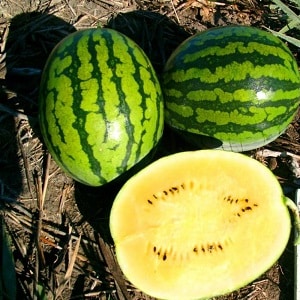 Lunar (on the picture). The fruit has an elliptical shape and a smooth skin. The flesh of ripe watermelons is yellow in color and has a delicate sweet taste. Ripen after 3 months from germination. This variety retains its flavor for a month after harvest.
Lunar (on the picture). The fruit has an elliptical shape and a smooth skin. The flesh of ripe watermelons is yellow in color and has a delicate sweet taste. Ripen after 3 months from germination. This variety retains its flavor for a month after harvest.- Black Prince. Ripens in approximately 100 days. The ripe fruit is cylindrical in shape and dark green in color. The pulp has an impeccable taste. This culture is unpretentious and resistant to high and low temperatures. Watermelons are stored for up to 50 days after picking.
- Volzhanin. Ripens after 3 months from germination. The fruit has a green tint with a mesh pattern in the form of prickly stripes. It has excellent taste and juicy pulp. Volzhanin is resistant to drought and parasites.
Late ripening
Late ripening watermelons cultivated in areas with hot and long summers. Such fruits take a long time to ripen and accumulate a record amount of sugar. Late-ripening watermelons have a rough and dense rind. They reach large sizes - up to 25 kg. Late plants are resistant to excess and lack of moisture and various diseases.
They are characterized by a slower process of sugar synthesis. Thanks to this, such varieties retain their taste and elasticity for 5-6 months after harvesting.
The most delicious among them:
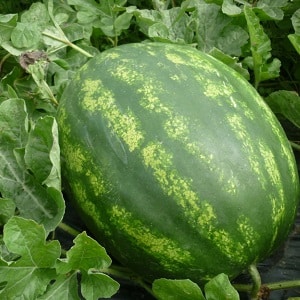 Chill (on the picture). The first fruit ripens 3 months after the sprouts appear. This is a plant with a powerful bush and large leaves. The ripe fruit reaches a weight of 25 kg. Watermelons can be stored for 3 months without losing their taste. Chill is susceptible to temperature changes and parasites.
Chill (on the picture). The first fruit ripens 3 months after the sprouts appear. This is a plant with a powerful bush and large leaves. The ripe fruit reaches a weight of 25 kg. Watermelons can be stored for 3 months without losing their taste. Chill is susceptible to temperature changes and parasites.- Bush 334. The first fruit ripens after 100 days. The pulp is tender and soft.Has a rich sweet taste. If properly harvested and properly collected and stored, it can last for several months. Immune to fungal diseases and parasites.
- Spring. Gives a harvest 100 days after planting. It has small fruits with an elongated spherical shape. The peel color is olive-green with a weakly defined mesh. The pulp of the plant has a rich scarlet color and a delicate and juicy texture. Has a pronounced honey taste. These watermelons can be pickled.
- Icarus. Ripens in 100 days. The fruit has an elliptical shape and weighs up to 15 kg. The pulp has a raspberry hue. Can be stored for 6 months after harvest.
Reference. Late-ripening watermelons fully ripen only in the south. There is difficulty in determining the true ripeness of the fruit. Due to the long growing season, large fruits are often unsweetened.
Other
It is also worth highlighting early ripening varieties and hybrids of watermelons, which ripen after 50 days after landing. At the same time, they have a small mass - a maximum of 7 kg.
The most delicious among them:
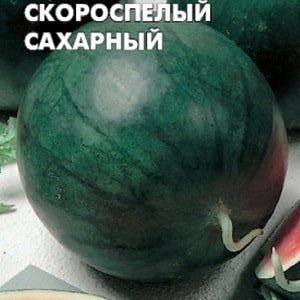 Sugar early ripening. Ripens in 50-60 days. The fruits are round in shape and small in size. They have a pronounced sugary and juicy taste. Unpretentious in care.
Sugar early ripening. Ripens in 50-60 days. The fruits are round in shape and small in size. They have a pronounced sugary and juicy taste. Unpretentious in care.- Eureka F1. It is a medium-sized round fruit. Its weight reaches 8 kg. Has a dark green color. Watermelon tastes sugary and juicy. Resistant to fungal diseases and changing weather conditions.
- Turbo F1. Ripens within a month and a half after planting. This is an oval berry weighing up to 10 kg. Has a dark green color. It has a sugary and juicy taste.
- Lady F1. Ripens in 50 days. The skin of the fruit is dense. The peel is yellow-green with small stripes. The structure of the pulp is tender and crumbly. The taste is juicy and sweet.
Reference. Early ripening fruits have high yields. From one bush you can collect up to 10 kg of ripe watermelons.
The best productive varieties and hybrids
For a good watermelon harvest you need:
- bright afternoon sun;
- warm nights;
- loose soil in the root area.
For regions with cool climates, unpretentious varieties and hybrids of watermelons are suitable. It is better to plant them through seedlings in greenhouses. The hardiest hybrid crops are suitable for open ground.
Description and characteristics
Let's list the most fruitful varieties and hybrids of watermelons:
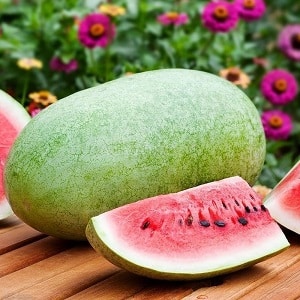 Charleston gray (on the picture). This variety brings up to 100 t/ha of yield. The ripe fruit weighs up to 14 kg and has a longitudinal oval shape. The berry has a juicy taste and a long shelf life.
Charleston gray (on the picture). This variety brings up to 100 t/ha of yield. The ripe fruit weighs up to 14 kg and has a longitudinal oval shape. The berry has a juicy taste and a long shelf life.- Crimson Sweet. Productivity – 60-70 t/ha. The weight of a ripe plant reaches 12 kg. Watermelon pulp has a rich red color and a sweet taste.
- Delicacy F1. Brings up to 40 t/ha of ripe fruits. This hybrid is characterized by a dense peel and raspberry color of the pulp. Weight – 10 kg. The shape is round. Easy to care for. Tasty and juicy.
- Chill. The variety has a high yield of 35 t/ha. Weighs between 5-7 kg. Can be stored for a long time after collection and is transportable. The flesh of a ripe watermelon is deep scarlet in color, with a pronounced sweet taste.
How to choose a variety or hybrid based on ripening time
The choice of crop for cultivation in a particular region depends on the period of fruit ripening.. All varieties are suitable for southern territories. In the northern parts, the harvest comes exclusively early.
Description and characteristics
In irrigated areas, the average yield of watermelons is 400-500 c/ha, in non-irrigated areas - 200-250 c/ha.Under favorable growing conditions, some fruits reach a weight of 26 kg or more.
Amateur melon growers grow on average 6-8 kg per square meter. m. Some manage to achieve a yield of up to 20 kg per square meter. m.
- Most modern watermelons ripen in 60-80 days. Early ripening fruits are unpretentious in care and tolerate heat and cold well. In the southern regions they can reach a weight of up to 15 kg. The most popular of the early ripening ones: Sandai Special, Sugar Baby, Eureka, Lady F1, Lunar, Regus F1, Ogonyok, Zenit and others.
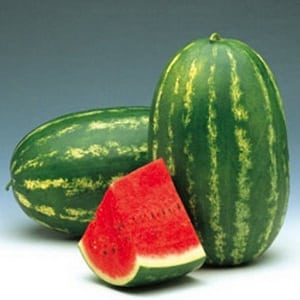 Mid-season species ripen in southern soil and northern greenhouses. Such varieties gain the required mass in the open air of the North Caucasus and in the lower reaches of the Volga. In the northern areas, these fruits can only ripen in greenhouses and greenhouses. This requires proper care and high-quality agricultural technology. The most popular mid-season varieties and hybrids: Delicatessen F1, Volzhanin (pictured), Crimlong F1, Florida F1, Crimson Sweet, Black Prince, etc.
Mid-season species ripen in southern soil and northern greenhouses. Such varieties gain the required mass in the open air of the North Caucasus and in the lower reaches of the Volga. In the northern areas, these fruits can only ripen in greenhouses and greenhouses. This requires proper care and high-quality agricultural technology. The most popular mid-season varieties and hybrids: Delicatessen F1, Volzhanin (pictured), Crimlong F1, Florida F1, Crimson Sweet, Black Prince, etc.- Late-ripening varieties and hybrids ripen slowly. They are cultivated in regions with warm climates and long summers. They need to be cut in September or November, depending on the weather. For planting, it is better to choose varieties: Kholodok, Chervonny Korol, Icarus, Lyubimets of Pyatigorsk, etc. Their disadvantage is that it is often difficult to determine ripeness. A seemingly large and ripe fruit may turn out to be unripe.
The sweetest varieties or hybrids of watermelons
Watermelon is one of the sweetest foods on our tables.. The sugar content in fruits varies from 5 to 10 g per 100 g of pulp, depending on the variety. The energy value of a serving is from 45 kcal. The sugar content is determined by fructose, which in watermelon predominates over glucose and sucrose.
Sweet taste is the most important criterion when choosing a berry. Unsweetened crops are suitable for canning; for fresh consumption, the watermelon must be juicy and tasty.
Description and characteristics
Among sugar and juicy fruits there are:
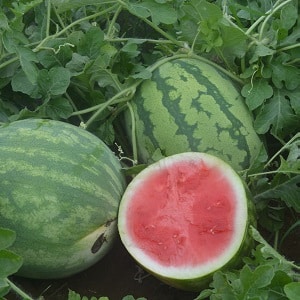 Melitopolsky 60 (on the picture). The sugar content in the berry reaches 12%. The variety has a long shelf life. Reaches a weight of 10 kg. The flesh of the watermelon is pale pink, very juicy and tasty.
Melitopolsky 60 (on the picture). The sugar content in the berry reaches 12%. The variety has a long shelf life. Reaches a weight of 10 kg. The flesh of the watermelon is pale pink, very juicy and tasty.- Winner 395. Contains 9-11% sugar. It has a pronounced sweet taste.
- Bykovsky. Includes 9.5% glucose. The flesh of these watermelons is pink and grainy. The taste is sweet, juicy.
- Favorite of Pyatigorsk. 8.5% sugar in the composition. It has a delicate, honey taste. It cannot be stored for long periods of time as it quickly deteriorates. Must be consumed immediately after collection.
- Zenith. The glucose content reaches 8.2%. The round fruits have purple and granular flesh. Juicy and sweet.
- Volzhanin. Recognized as one of the sweetest and juiciest fruits. Sugar content – 7.2%.
Reference. Patients with diabetes are advised to consume watermelon in limited quantities so as not to exceed the blood glucose level. The permissible norm is up to 200 g per day.
Unusual varieties of watermelons
Unusual varieties include:
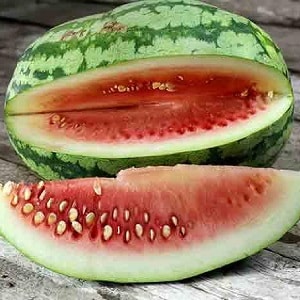 American hybrid Carolina Cross (on the picture). It has very large fruits - 90-119 kg.
American hybrid Carolina Cross (on the picture). It has very large fruits - 90-119 kg.- Hokkaido Densukke. The rind of these watermelons is almost black in color.
- Pepkinos. It is characterized by small fruits smaller than an apple.
- King of Hearts. This seedless variety is suitable for those who do not like seeds. The fruit has an unusual, nutmeg taste.
Reference. Watermelons with unusual shapes are at the peak of their popularity. In Japan, cultivation of square fruits has been established.Local gardeners are also trying to create atypical shapes: pyramid, cone, rectangle, heart, etc. Due to their unusual shape, the price for such plants is much higher than for ordinary fruits.
Tips and recommendations for choosing and growing watermelons from experienced gardeners
Experienced melon growers when choosing watermelon varieties, it is advised to take into account their adaptability to the climate of the region. Planting seeds directly into open ground makes sense only in the southern regions of Russia. In other areas, growing seedlings is necessary to obtain a harvest.
In central Russia, melon growers recommend planting early-ripening fruits. Such crops are the most unpretentious and resistant to adverse conditions. In regions with cool summers, it is recommended to plant watermelons in greenhouses. The best time for planting seedlings is the end of May - beginning of June. This means the seeds themselves are planted at the end of April.
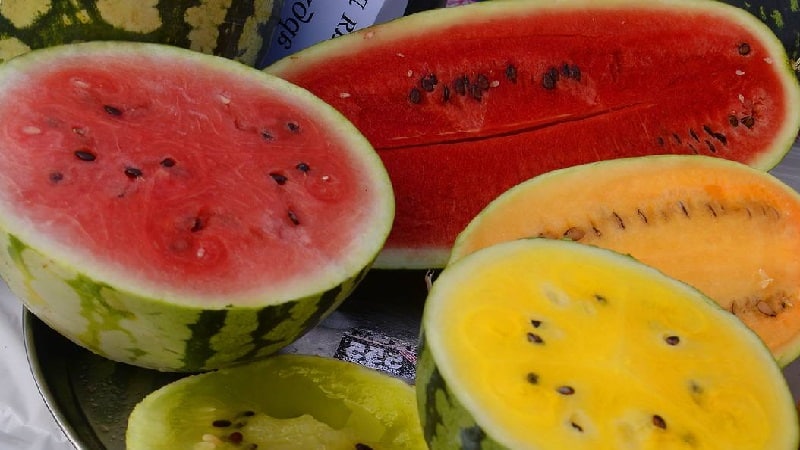
Feedback from melon growers confirms the following conclusions:
Andrey, Saratov: “I have been growing melons for many years. I grow different varieties of berries. I advise you to give preference to early ripening watermelons. The best among them, in my opinion, are Ogonyok, Sweet Diamond, Sugar Baby and Lightning. In order for the harvest to be rich, you need to observe the correct planting of seeds. Then the watermelons ripen quickly. After about 1.5-2 months you can harvest. All these fruits are sugary and juicy.".
Antonina, Kalmykia: “I plant watermelons every year. I recommend early-ripening and early-ripening varieties for the garden. I myself plant Ogonyok, Gift to the North, Producer and Ataman. The berries grow large and very sweet. The yield is always good. I collect up to 7 fruits from each bush. Early ripening varieties are unpretentious and do not require special care. And in terms of taste, they are the best".
So, to grow watermelons, you need:
- select varieties that are optimally suited to your climatic conditions, soil and irrigation;
- observe temperature and light conditions;
- fertilize and water the soil on time;
- choose the color and shape according to your preference;
- take into account the thickness of the peel, the structure of the pulp and the number of seeds.
Conclusion
It is impossible to definitely select the most delicious and productive variety. Early-ripening and early-ripening watermelons are grown in regions with a cool climate and short summers. They are small in size and not intended for long-term storage.
Mid-ripening and late-ripening varieties are distinguished by long ripening. Thanks to this, they are more sugary and juicy and can be stored for up to six months. The ripeness of these varieties can only be achieved in regions with hot and long summers.